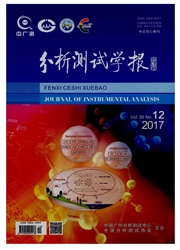

 中文摘要:
中文摘要:
用原子力显微镜检测了不同浓度下皂苷和皂苷元的分子聚集相行为。实验表明,当浓度为1.0×10^-5mol/L时,皂苷形成分散较均匀的小片段结构,表现为皂苷分子的聚集体结构;而皂苷元由多个分子连接形成聚集体结构,与皂苷相比高度起伏较低,链的长度较长。浓度为1.0×10^-4mol/L时,皂苷出现了不规则片层与小片段共存结构;皂苷元却形成多孔的网状结构。当浓度增大到1.0×10^-3mol/L时,皂苷小分子紧密聚集、分布在云母表面;皂苷元则形成紧密聚集的大片层多孔结构。结构分析表明,分子官能团的属性对于皂苷和皂苷元分子形成的不同结构起到了关键作用,分子骨架中的糖链阻碍皂苷形成大片层结构,而皂苷元由于分子骨架中羟基间氢键相连接,易于形成大的片层结构。
 英文摘要:
英文摘要:
The aggregation force microscope (AFM). behaviors of dioscin and The resutt indicated that diosgenin molecules were observed with atomic the aggregation behavior of dioscin was different with that of diosgenin. At the concentration of 1.0 ×10^-5 mol/L, dioscin was aggregated to form uniform small segment and rod like structure with length of 200 nm, height of 6.92 nm and roughness of 1. 312 nm, but for the diosgenin, several molecules were linked to form aggregation structure with the lower height and longer length. As the concentration was increased to 1.0 × 10^-4 mol/L, some irregular sheet and small segment structure were observed in dioscin solution, while the shape of net structure with many holes was formed in diosgenin solution. When the concentration was reached to 1.0 × 10^-3 mol/L, the segment of dioscin was assembled tightly on the mica, and the diosgenin molecule was aggregated to form a lager sheet structure with many small holes. The analysis of molecule structure demonstrated that the molecule structure was the key factor for the different aggregation behavior of dioscin and diosgenin, in which dioscin was tend to form small sheet structure owing to the appearence of sugar chain in the molecule framework, and diosgenin molecule was tended to form the large sheet for the interaction between the hydroxyl group in the molecule framework. This study provides useful information for the further study on the interaction of drug and membrane.
 同期刊论文项目
同期刊论文项目
 同项目期刊论文
同项目期刊论文
 期刊信息
期刊信息
